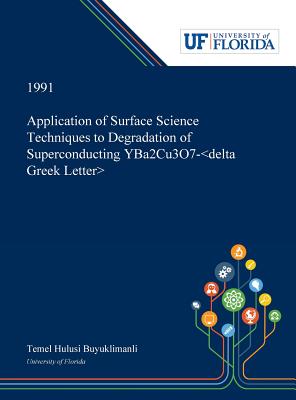Read Application of Surface Science Techniques to Degradation of Superconducting YBa2Cu3O7 - Temel Buyuklimanli | ePub
Related searches:
The scope of surface science goes beyond a broad range of academic fields, with real-world and commercial research applications. The science of surfaces goes on, performed by scientists who study it under hv/uhv conditions to describe both the chemical and physical properties of different and various materials to provide an understanding of the diverse properties as given below: ferroelectricity; piezoelectricity; tribology; catalysis.
Applied surface science covers topics contributing to a better understanding of surfaces, interfaces, nanostructures and their applications. The journal is concerned with scientific research on the atomic and molecular level of material properties determined with specific surface analytical techniques and/or computational methods, as well as the processing of such structures.
Read the latest articles of applications of surface science at sciencedirect. Com, elsevier’s leading platform of peer-reviewed scholarly literature.
Applications of surface science now known as applied surface science read 784 articles.
In this chapter we illustrate the applications of surface electron microscopy with slow electrons by examples selected from the extensive list of references, which should be accessible to most readers.
Surface science has existed as a recognized discipline for more than 20 years. During this period, the subject has expanded in two important ways. On the one hand, the techniques available for studying surfaces, both experimental and theoretical, have grown in number and in sophistication. On the other hand, surface science has been applied to an increasing number of areas of technology, such as catalysis, semicon ductor processing, new materials development, corrosion prevention, adhesion.
For a long time, it seems, men took the statement that beauty is only skin deep to mean they needn't muss and fuss over something as superficial as skin care our product picks are editor-tested, expert-approved.
Then the author examines colloidal systems and thin liquid films before moving on to emulsion science and technology.
Journal abbreviation: applications of surface science the abbreviation of the journal title applications of surface science is appl. � it is the recommended abbreviation to be used for abstracting, indexing and referencing purposes and meets all criteria of the iso 4 standard for abbreviating names of scientific journals.
Surface science model catalysts are elementary representations of applied systems by which different parameters of a catalytic process can be investigated separately and at the molecular scale. Studies on such model systems constitute the basis for present studies which aim at bridging the materials and pressure gap towards applied catalysts systematically.
Spatial (map) is considered as a core infrastructure of modern it world, which is substantiated by business transactions of major it companies such as apple, google, microsoft, amazon, intel, and uber, and even motor companies such as audi,.
18 dec 2017 surface science affects and contributes to areas: it, materials and interface science, biomaterials, biotechnology, medicine, nanotechnology.
Surface engineering is the sub-discipline of materials science which deals with the surface of solid matter. It has applications to chemistry, mechanical engineering, and electrical engineering (particularly in relation to semiconductor manufacturing).
In science, a product is what is formed is when two or more chemicals or raw materials react. There can be more than one product that is formed in a chemical reaction. The chemicals or raw materials that exist before the reaction are called.
The most downloaded articles from applied surface science advances in the last 90 days. Mechanism and technological opportunity of plasma electrolytic polishing of metals and alloys surfaces - open access.
26 nov 2020 of great interest in this field are nanomaterials, which have recently experienced breakthroughs in synthesis and application.
Fundamental insight into the mechanisms of corrosion of metals and alloys and their self‐protection by oxide passive films can be achieved with a surface science approach, applying surface analytical methods to model solid/liquid interfaces corroding under well‐controlled conditions.
New to sbir? check out this great infographic on the nih sbir/sttr webpage, and visit the the nih guide for grants and contracts to find additional opportunities. Nci sbir development center also releases an electronic publication containin.
The adhesive may be matched to the surface roughness by modifying the surface, or choosing a more appropriate adhesive. The science of adhesion educational series the science of adhesion educational series is designed to be a comprehensive introduction to adhesion science and the use of tapes and adhesives in design applications.
Ever wondered how to buy stock in science applications international corporation? we explain how and compare the best share dealing platforms. Plus a detailed analysis of the information technology services specialist's financials and forec.
Application-of-surface-science-to-advancing-flotation-technology.
Volumes 9 and 10 describe a range of applications of surface science, including: surface analytics with x-ray photoelectron and auger electron spectroscopy on coated steel sheets; wafer bonding; thin films; superconformal deposition; spintronics: surface and interface aspects; device efficiency of organic light-emitting diodes; dye-sensitized solar cells; application of graphene; electronic nose; industrial heterogeneous catalysis; automotive catalysis; high-throughput heterogeneous catalyst.
Surface science describes applications to examine the physics and chemistry of surfaces. Surface science studies are often conducted under controlled vacuum conditions. The development of highly sophisticated techniques like xrd (x-ray diffraction), xrf (x-ray fluorescence spectroscopy) or xrp (x-ray photoelectron spectroscopy) requires high demands on the used vacuum systems.
An excellent and comprehensive review of applications of surface analysis methods, mainly of xps and sims to teeth, bones, dental and related biomaterials has been published before.
All nanomaterials share a common feature of large surface-to-volume ratio, making essential component of nanomaterial synthesis, processing and application.
The field of surface science extends across a wide range of academic fields, with both commercial and real-world research applications. The science of surfaces continues, undertaken by researchers who explore it under hv/uhv conditions to illustrate both the physical and chemical characteristics of many and varied materials, to offer insights into properties as diverse as the below: electronic and optical; quantum phenomena; catalysis.

Post Your Comments: